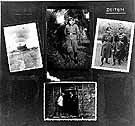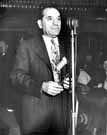
|
|
|

|

|

|

|
|
Click on an image to see a larger, more detailed picture.
|
|
|
|
|
| 1943: Death and Resistance |

|
pg. 475 |

|
|
|
|
| |
 This is a page from the scrapbook of Kurt Franz, deputy commandant of the Treblinka death camp. After arriving there in the late summer of 1942, Franz began to keep an extensive photographic record of events in the camp. He later wrote, "Everywhere there were corpses. I remember that these corpses were already bloated." Franz was among the Treblinka personnel tried between October 1964 and August 1965. He was sentenced to life in prison.
This is a page from the scrapbook of Kurt Franz, deputy commandant of the Treblinka death camp. After arriving there in the late summer of 1942, Franz began to keep an extensive photographic record of events in the camp. He later wrote, "Everywhere there were corpses. I remember that these corpses were already bloated." Franz was among the Treblinka personnel tried between October 1964 and August 1965. He was sentenced to life in prison.
Photo: Yad Vashem / United States Holocaust Memorial Museum Photo Archive
|
 A Jewish volunteer in a coastal artillery battery holds a shell on which is inscribed in Hebrew: "A gift for Hitler." Formed in 1940, these units served as part of the British force in Palestine. As news of the death camps reached Palestine, the desire for revenge grew among Jewish troops. Ultimately, the British agreed to form the Jewish Brigade Group.
A Jewish volunteer in a coastal artillery battery holds a shell on which is inscribed in Hebrew: "A gift for Hitler." Formed in 1940, these units served as part of the British force in Palestine. As news of the death camps reached Palestine, the desire for revenge grew among Jewish troops. Ultimately, the British agreed to form the Jewish Brigade Group.
Photo: Central Zionist Archives / United States Holocaust Memorial Museum Photo Archive
|
 American Jewish Conference
American Jewish Conference
The American Jewish Conference was organized in 1943 by the American Zionist movement. Recognizing that war often results in great political change, many American Jews believed that the time to lobby for the creation of a Jewish state in Palestine was when the Second World War and the Holocaust had ended. Almost every American-Jewish organization was represented in the 1943 convention of more than 500 delegates. Because the conference seemed more interested in establishing a Jewish state than in focusing on the rescue of European Jews, several Jewish organizations--especially the American Jewish Committee--criticized the conference's lack of emphasis on rescuing Holocaust victims. Moreover, the conference--established by Henry Monsky (pictured)--failed in its attempt to influence the U.S. government on the Palestine issue. Not until January 1945 did the conference urge rescue and aid for the Jews of Europe. The conference was a harbinger of wide American-Jewish commitment to the establishment of Israel. In September 1945 a Roper poll indicated that 80 percent of American Jews favored the Zionist position. The most significant achievement of the conference was helping to swing American non-Jewish and political opinion in favor of the creation of a postwar home for the Jews of Europe.
Photo: United States Holocaust Memorial Museum Photo Archive
|
|

|

|

|

|
 Late August 1943: Forty-seven Jewish women and 50 Jewish men are executed after being discovered in the "Aryan" section of Warsaw.
Late August 1943: Forty-seven Jewish women and 50 Jewish men are executed after being discovered in the "Aryan" section of Warsaw.
|
 September 1943: Germans send a Polish labor battalion into the ruins of the Warsaw Ghetto to flatten any walls and other structures still standing following the German assault of the previous spring. Most survivors of the April-May "liquidation" die during this demolition.
September 1943: Germans send a Polish labor battalion into the ruins of the Warsaw Ghetto to flatten any walls and other structures still standing following the German assault of the previous spring. Most survivors of the April-May "liquidation" die during this demolition.
|
 September 1943: The American Council for Judaism declares that Jewishness exists in a religious sense only, and that attempts to establish a Jewish homeland would be disloyal to the homeland nations of individual Jews.
September 1943: The American Council for Judaism declares that Jewishness exists in a religious sense only, and that attempts to establish a Jewish homeland would be disloyal to the homeland nations of individual Jews.
|
 September 1943: Jews at the Sobibór death camp attack SS guards with stones and bottles. All attackers are killed.
September 1943: Jews at the Sobibór death camp attack SS guards with stones and bottles. All attackers are killed.
|
 September 1943: Jewish women and children, as well as the elderly and the sick, left on the island of Rab after deportation from Dalmatia, Serbia, are transferred to a concentration camp at Zemun, Yugoslavia, and killed. Others remain on the island and are protected by partisans.
September 1943: Jewish women and children, as well as the elderly and the sick, left on the island of Rab after deportation from Dalmatia, Serbia, are transferred to a concentration camp at Zemun, Yugoslavia, and killed. Others remain on the island and are protected by partisans.
|
|
|
|
|
| 1943: Death and Resistance |

|
pg. 475 |

|
|
The Holocaust Chronicle
© 2009 Publications International, Ltd.
|
|
